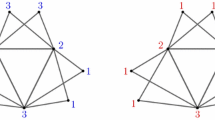Abstract
We study the behavior of the Douglas–Rachford algorithm on the graph vertex-coloring problem. Given a graph and a number of colors, the goal is to find a coloring of the vertices so that all adjacent vertex pairs have different colors. In spite of the combinatorial nature of this problem, the Douglas–Rachford algorithm was recently shown to be a successful heuristic for solving a wide variety of graph coloring instances, when the problem was cast as a feasibility problem on binary indicator variables. In this work we consider a different formulation, based on semidefinite programming. The much improved performance of the Douglas–Rachford algorithm, with this new approach, is demonstrated through various numerical experiments.












Similar content being viewed by others
Notes
top95: http://magictour.free.fr/top95.
DIMACS benchmark instances: http://cse.unl.edu/~tnguyen/npbenchmarks/graphcoloring.html.
References
Achlioptas, D., Friedgut, E.: A sharp threshold for \(k\)-colorability. Random Struct. Algorithm 14, 63–70 (1999)
Achlioptas, D., Molloy, M.: Almost all graphs with \(2.522n\) edges are not 3-colorable. Electron. J. Comb. 6(1), R29 (1999)
Aragón Artacho, F.J., Borwein, J.M., Martín-Márquez, V., Yao, L.: Applications of convex analysis within mathematics. Math. Program. Ser. B 148(1–2), 49–88 (2014)
Aragón Artacho, F.J., Borwein, J.M., Tam, M.K.: Douglas–Rachford feasibility methods for matrix completion problems. ANZIAM J. 55(4), 299–326 (2014)
Aragón Artacho, F.J., Borwein, J.M., Tam, M.K.: Recent results on Douglas–Rachford methods for combinatorial optimization problem. J. Optim. Theory Appl. 163(1), 1–30 (2014)
Aragón Artacho, F.J., Borwein, J.M., Tam, M.K.: Global behavior of the Douglas–Rachford method for a nonconvex feasibility problem. J. Glob. Optim. 65(2), 309–327 (2016)
Aragón Artacho, F.J., Campoy, R.: Solving graph coloring problems with the Douglas–Rachford algorithm. Set Valued Var. Anal. 26(2), 277–304 (2018)
Baillon, J.B., Bruck, R.E., Reich, S.: On the asymptotic behavior of nonexpansive mappings and semigroups in Banach spaces. Houst. J. Math. 4(1), 1–9 (1978)
Bauschke, H.H., Combettes, P.L.: Convex Analysis and Monotone Operator Theory in Hilbert Spaces, 2nd edn. Springer, Berlin (2017)
Bauschke, H.H., Koch, V.R.: Projection methods: Swiss army knives for solving feasibility and best approximation problems with halfspaces. Contemp. Math. 636, 1–40 (2015)
Bauschke, H.H., Noll, D.: On the local convergence of the Douglas–Rachford algorithm. Arch. Math. 102(6), 589–600 (2014)
Benoist, J.: The Douglas–Rachford algorithm for the case of the sphere and the line. J. Glob. Optim. 63(2), 363–380 (2015)
Cegielski, A.: Iterative methods for fixed point problems in Hilbert spaces. Lecture Notes in Mathematics, vol. 2057. Springer, Heidelberg (2012)
Chaitin, G.J.: Register allocation and spilling via graph coloring. SIGPLAN Not. 39(4), 66–74 (2004)
Dolan, E.D., Moré, J.J.: Benchmarking optimization software with performance profiles. Math. Program. Ser. A 91(2), 201–213 (2002)
Elser, V., Rankenburg, I., Thibault, P.: Searching with iterated maps. Proc. Natl. Acad. Sci. 104(2), 418–423 (2007)
Erdös, P., Rényi, A.: On random graphs I. Publ. Math. Debr. 6, 290–297 (1959)
Formanowicz, P., Tanaś, K.: A survey of graph coloring—its types, methods and applications. Found. Comput. Decis. Sci. 37(3), 223–238 (2012)
Garey, M.R., Johnson, D.S., So, H.C.: An application of graph coloring to printed circuit testing. IEEE Trans. Circuits Syst. 23(10), 591–599 (1976)
Hale, W.K.: Frequency assignment: theory and applications. Proc. IEEE 68(12), 1497–1514 (1980)
Hesse, R., Luke, D.R.: Nonconvex notions of regularity and convergence of fundamental algorithms for feasibility problems. SIAM J. Optim. 23(4), 2397–2419 (2013)
Horn, R.A., Johnson, C.R.: Matrix Analysis, 2nd edn. Cambridge University Press, Cambridge (2013)
Izmailov, A.F., Solodov, M.V., Uskov, E.T.: Globalizing stabilized sequential quadratic programming method by smooth primal-dual exact penalty function. J. Optim. Theory Appl. 169(1), 1–31 (2016)
Jensen, T.R., Toft, B.: Graph Coloring Problems. Wiley, New York (1995)
Johansson, F: mpmath, version 1.0 (2017). http://mpmath.org
Karger, D., Motwani, R., Sudan, M.: Approximate graph coloring by semidefinite programming. J. ACM (JACM) 45(2), 246–265 (1998)
Karp, R.M.: Reducibility among combinatorial problems. In: Miller, R., Thatcher, J. (eds.) Complexity of Computer Computations, pp. 85–103. Plenum Press, New York (1972)
Leighton, F.T.: A graph coloring algorithm for large scheduling problems. J. Res. Natl. Bur. Stand. 84(6), 489–506 (1979)
Lewis, R.M.R.: A Guide to Graph Colouring: Algorithms and Applications. Springer, New York (2016)
OEIS Foundation Inc.: The on-line encyclopedia of integer sequences (2018). https://oeis.org/A088202
Pardalos, P.M., Mavridou, T., Xue, J.: The graph coloring problem: a bibliographic survey. In: Du, D.-Z., Pardalos, P.M. (eds.) Handbook of Combinatorial Optimization, pp. 1077–1141. Springer, New York (1998)
Phan, H.M.: Linear convergence of the Douglas–Rachford method for two closed sets. Optimization 65(2), 369–385 (2016)
Pierra, G.: Decomposition through formalization in a product space. Math. Program. 28, 96–115 (1984)
Tam, M.K.: Regularity properties of non-negative sparsity sets. J. Math. Anal. Appl. 447(2), 758–777 (2017)
Acknowledgements
This work was initiated during the BIRS workshop on Splitting Algorithms, Modern Operator Theory, and Applications, organized by Heinz Bauschke, Regina Burachik and Russell Luke in Oaxaca (Mexico), in 2017. The authors thank the organizers for an excellent meeting and bringing us together.
Author information
Authors and Affiliations
Corresponding author
Additional information
Publisher's Note
Springer Nature remains neutral with regard to jurisdictional claims in published maps and institutional affiliations.
F. J. Aragón Artacho and R. Campoy were partially supported by MICINN of Spain and ERDF of EU, Grants MTM2014-59179-C2-1-P and PGC2018-097960-B-C22. F. J. Aragón Artacho was supported by the Ramón y Cajal program by MINECO of Spain and ERDF of EU (RYC-2013-13327) and R. Campoy was supported by MINECO of Spain and ESF of EU (BES-2015-073360) under the program “Ayudas para contratos predoctorales para la formación de doctores 2015”.
Rights and permissions
About this article
Cite this article
Aragón Artacho, F.J., Campoy, R. & Elser, V. An enhanced formulation for solving graph coloring problems with the Douglas–Rachford algorithm. J Glob Optim 77, 383–403 (2020). https://doi.org/10.1007/s10898-019-00867-x
Received:
Accepted:
Published:
Issue Date:
DOI: https://doi.org/10.1007/s10898-019-00867-x




